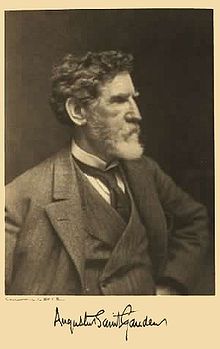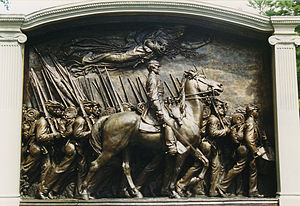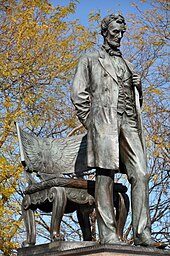Augustus Saint-Gaudens (/É"ËˈɡʌstÉ™s ËŒseɪntˈɡÉ'ËdÉ™ns/; March 1, 1848 â€" August 3, 1907) was an American sculptor of the Beaux-Arts generation who most embodied the ideals of the "American Renaissance". Raised in New York City, he traveled to Europe for further training and artistic study, and then returned to New York, where he achieved major critical success for his monuments commemorating heroes of the American Civil War, many of which still stand. In addition to his famous works such as the Robert Gould Shaw Memorial on Boston Common and the outstanding grand equestrian monuments to Civil War Generals, John A. Logan atop a pedestal done by the architectural firm of McKim, Mead & White, assisted by the Chicago architect Daniel H. Burnham in Chicago, 1894â€"97, and William Tecumseh Sherman, at the corner of New York's Central Park, 1892â€"1903, Saint-Gaudens also maintained an interest in numismatics. He designed the $20 "double eagle" gold piece, for the US Mint in 1905â€"1907, considered one of the most beautiful American coins ever issued as well as the $10 "Indian Head" gold eagle, both of which were minted from 1907 until 1933. In his later years he founded the "Cornish Colony", an artistic colony that included notable painters, sculptors, writers, and architects. His brother Louis Saint-Gaudens was also a well-known sculptor with whom he occasionally collaborated.
Early life and career

Born in Dublin to a French father and an Irish mother, Saint-Gaudens was raised in New York, after his parents immigrated to America when he was six months of age. He was apprenticed to a cameo-cutter but also took art classes at the Cooper Union and the National Academy of Design.
At 19, his apprenticeship completed, he traveled to Paris in 1867, where he studied in the atelier of François Jouffroy at the École des Beaux-Arts.
In 1870, he left Paris for Rome, to study art and architecture, and worked on his first commissions. There he met a deaf American art student, Augusta Fisher Homer,whom he married on June 1, 1877 whose sister was Elizabeth Fisher [Homer] Nichols
In 1876, he won a commission for a bronze David Farragut Memorial. He rented a studio at 49 rue Notre Dame des Champs. Stanford White designed the pedestal. It was unveiled on May 25, 1881, in Madison Square Park. He collaborated with Stanford White again in 1892-94 when he created Diana as a weather vane for the second Madison Square Garden building in New York City; a second version used is now in the collection of the Philadelphia Museum of Art, with several reduced versions in museums including the Metropolitan Museum of Art in New York City. The statue stood on a 300-foot-high tower, making "Diana" the highest point in the city. It was also the first statue in that part of Manhattan to be lit at night by electricity. The statue and its tower was a landmark until 1925 when the building was demolished.
In New York, he was a member of the Tilers, a group of prominent artists and writers, including Winslow Homer (his wife's fourth cousin), William Merritt Chase and Arthur Quartley. He was also a member of the Salmagundi Club in New York.
Civil War commemorative commissions

In 1876, Saint-Gaudens received his first major commission: a monument to Civil War Admiral David Farragut, in New York's Madison Square; his friend Stanford White designed an architectural setting for it, and when it was unveiled in 1881, its naturalism, its lack of bombast and its siting combined to make it a tremendous success, and Saint-Gaudens' reputation was established.
The commissions followed fast, including the colossal Standing Lincoln in Lincoln Park, Chicago in a setting by architect White, 1884â€"1887, considered the finest portrait statue in the United States (a replica was placed at Lincoln's tomb in Springfield, Illinois, and another stands in London, facing Parliament Square), and a long series of funerary monuments and busts, including the Adams Memorial, the Peter Cooper Monument, and the John A. Logan Monument.
Arguably the greatest of these funerary monuments is the bronze bas-relief that forms the Robert Gould Shaw Memorial on Boston Common, 1884â€"1897, which Saint-Gaudens labored on for 14 years; even after the public version had been unveiled, he continued with further versions. Two grand equestrian monuments to Civil War generals are outstanding: to General John A. Logan, atop a tumulus in Chicago, 1894â€"1897, and to William Tecumseh Sherman at the corner of Central Park in New York, 1892â€"1903, the first use of Robert Treat Paine's pointing device for the accurate mechanical enlargement of sculpture models. The depictions of the African-American soldiers on the memorial is noted as a rare example of true-to-life, non-derogatory, depictions of Afro-ancestral physical characteristics in 19th Century American art.
For the Lincoln Centennial in 1909, Saint-Gaudens produced another statue of the president. A seated figure, Abraham Lincoln: The Head of State, is in Chicago's Grant Park. Saint-Gaudens completed the design work and had begun casting the statue at the time of his deathâ€"his workshop completed it. The statue's head was used as the model for the commemorative postage stamp issued on the 100th anniversary of Lincoln's birth.
Other works

Saint-Gaudens also created the statue for the Charles Stewart Parnell monument at the North end of Dublin's O'Connell Street, that was finally installed in 1911.
In 1887, when Robert Louis Stevenson made his second trip to the United States, Saint-Gaudens had the opportunity to make the preliminary sketches for a five-year project of a medallion depicting Stevenson, in very poor health at the time, propped in bed writing. With minor modifications, this medallion was reproduced for the Stevenson memorial in St. Giles' Cathedral, Edinburgh. Stevenson's cousin and biographer, Graham Balfour, deemed the work "the most satisfactory of all the portraits of Stevenson." Balfour also noted that Saint-Gaudens greatly admired Stevenson and had once said he would "gladly go a thousand miles for the sake of a sitting" with him.[2]
Saint-Gaudens was also commissioned by a variety of groups to create medals including varied commemorative themes like The Women"s Auxiliary of the Massachusetts Civil Service Reform Association Presentation Medal and the World's Columbian Exposition Medal. Such pieces stand testament to both his broad appeal and the respect that was given to him by his contemporaries. Today, his medals have lost none of their allure and have been sold at auction for varying sums.
A statue of philanthropist Robert Randall stands in the gardens of Sailors' Snug Harbor in New York. A statue of copper king Marcus Daly, is at the entrance of the Montana School of Mines on the west end of Park St. in Butte, Montana. A statue of former United States Congressman and New York Governor Roswell Pettibone Flower was dedicated in 1902 in Watertown, New York.
Teacher and advisor

Saint-Gaudens' prominence brought him students, and he was an able and sensitive teacher. He tutored young artists privately, taught at the Art Students League of New York, and took on a large number of assistants. He was an artistic advisor to the World's Columbian Exposition of 1893, an avid supporter of the American Academy in Rome, and part of the McMillan Commission, which brought into being L'Enfant's long-ignored master-plan for the nation's capital.
Through his career Augustus Saint-Gaudens' made a specialty of intimate private portrait panels in sensitive, very low relief, which owed something to the Florentine Renaissance. It was felt he heavily influenced another Irish American sculptor, Jerome Connor.
Over the course of his long career Saint-Gaudens employed, and by doing so, trained, some of the next generation's finest sculptors. These included James Earle Fraser, Frances Grimes, Henry Hering, Charles Keck, Mary Lawrence, Frederick MacMonnies, Philip Martiny, Helen Mears, Robert Paine, Alexander Phimister Proctor, Louis Saint-Gaudens, Elsie Ward and Adolph Alexander Weinman.
New York City's PS40 is named after Saint-Gaudens.
Coinage

Saint-Gaudens referred to his early relief portraits as "medallions" and took a great interest in the art of the coin: his $20 gold piece, the double eagle coin he designed for the US Mint, 1905â€"1907, though it was adapted for minting, is still considered one of the most beautiful American coins ever issued.
Chosen by Theodore Roosevelt to redesign the coinage of the nation at the beginning of the 20th century, Saint-Gaudens produced a beautiful ultra high-relief $20 gold piece that was adapted into a flattened-down version by the United States Mint. The ultra high-relief coin took up to 11 strikes to bring up the details, and only 20 or so of these coins were minted in 1907. The Ultra High Reliefs did not stack properly and were deemed unfit for commerce. However, they are highly sought-after today; one sold in a 2005 auction for $2,990,000. The coin was then adapted into the High relief version, which, although requiring eight fewer strikes than the Ultra High Relief coins, was still deemed impractical for commerce. 12,317 of these were minted, and are currently among the most in-demand U.S. coins. The coin was finally modified to a normal-relief version, which was minted from 1907 to 1933.
The Saint-Gaudens obverse design was reused in the American Eagle gold bullion coins that were instituted in 1986. An "ultra-high relief" $20 (24 karat) gold coin was issued by the U.S. Mint in 2009.
Honored on US postage

In 1940 the U.S. Post Office issued a series of 35 postage stamps, 'The Famous American Series' honoring America's famous artists, poets, educators, authors, scientists, composers and inventors. The renowned sculptor Augustus Saint-Gaudens was among those chosen for the 'Artists' category of this series and appears on this stamp, which was first issued in New York City on September 16, 1940.
Later life and the Cornish Colony

Diagnosed with cancer in 1900, Saint-Gaudens decided to live at his Federal house with barn-studio set in the handsome gardens he had made, where he and his family had been spending summers since 1885, in Cornish, New Hampshire â€" though not in retirement. Despite waning energy, he continued to work, producing a steady stream of reliefs and public sculpture. In 1904, he was one of the first seven chosen for membership in the American Academy of Arts and Letters. That same year the large studio burned, with the irreplaceable loss of the sculptor's correspondence, his sketch books, and many works in progress.
The Cornish Art Colony Saint-Gaudens and his brother Louis attracted made for a dynamic social and creative environment. The most famous included painters Maxfield Parrish and Kenyon Cox, architect and garden designer Charles A. Platt, and sculptor Paul Manship. Included were painters Thomas Dewing, George de Forest Brush, dramatist Percy MacKaye, the American novelist Winston Churchill, and the sculptor Louis St. Gaudens, Augustus' brother. After his death in 1907 it slowly dissipated. His house and gardens are now preserved as the Saint-Gaudens National Historic Site.
Saint-Gaudens was elected a member of the American Academy of Arts and Sciences in 1896. In 1901, the French government made him an Officier de la Légion d'honneur. In 1920, Saint-Gaudens was posthumously elected to the Hall of Fame for Great Americans. In 1940, his image appeared on a U.S. postage stamp in the "Famous Americans" series.
Saint-Gaudens and his wife figure prominently in the 2011 book The Greater Journey: Americans in Paris by historian David McCullough. In interviews upon the book's release, McCullough said the letters of Augusta Saint-Gaudens to her friends and family in the United States were among the richest primary sources he discovered in years of research into the lives of the American community in Paris in the late 19th century.
Legacy

New York City's PS40 is named after Saint-Gaudens.
Among the public collections holding works by Augustus Saint-Gaudens are:
Gallery

See also
- Society of American Artists
- Art Students League
References
Bibliography
- Armstrong, Craven, et al., 200 Years of American Sculpture, Whitney Museum of Art, NYC, 1976.
- Balfour, Graham, The Life of Robert Louis Stevenson, 12th ed. Metheun, London, 1913.
- Caffin, Charles H. (February 1904). "The Work of the Sculptor August Saint-Gaudens". The World's Work: A History of Our Time VII: 4403â€"4419. Retrieved 2015-05-16.Â
- Clemen, Paul, in Die Kunst, Munich, 1910.
- Cortissoz, Royal, Augustus Saint-Gaudens, New York, 1907.
- Craven, Wayne, Sculpture in America, Thomas Y. Crowell Co, NY, NY 1968.
- Dryfhout, John H., Augustus Saint-Gaudens: The Portrait Reliefs, The National Portrait Gallery, Smithsonian Institution, Grossman Publishers, NY 1969.
- Dryfhout, John H., The 1907 United States Gold Coinage, Eastern National Park & Monument Association 1996.
- Dryfhout, John H., The Works of Augustus Saint-Gaudens, University Press of New England, Hanover 1982.
- Greenthal, Kathryn (1985). Augustus Saint-Gaudens, master sculptor. New York: The Metropolitan Museum of Art. ISBNÂ 9780816187898.Â
- Saint - Gaudens, Zorn and the Goddesslike Miss Anderson by William E. Hagans - This article first appeared in the summer 2002 issue of American Art.
- Kvaran, Einar Einarsson, St. Gaudens’ America, unpublished manuscript.
- Podas Larson, Christine, St. Gaudens' New York Eagle: Rescue And Restoration Of St. Paul's First Outdoor Sculpture, Ramsey County History Quarterly V37 #3, Ramsey County Historical Society,St Paul, MN, 2002.
- Reynalds, Donald Martin, Masters of American Sculpture: The Figurative Tradition From the American Renaissance to the Millennium, Abbeville Press, NY 1993.
- C. Lewis Hind: Augustus Saint-Gaudens. Publisher: The International Studio, John Lane Company; New York 1908 - Internet Archive - online
- Augustus Saint-Gaudens - His Life: Chronology
- Augustus Saint-Gaudens - His Works: Chronology
- Photographic Reproductions of the Works of Augustus Saint-Gaudens
- Augustus Saint-Gaudens: The Reminiscences of Augustus Saint-Gaudens, Volume I. Edited and Amplified by Homer Saint-Gaudens, Published By The Century Co. New York, 1913 -Internet Archive - online
- The reminiscences of Augustus Saint-Gaudens. Edited and amplified by Homer Saint-Gaudens. Volume Two. - Internet Archive - online
- Abraham Lincoln Monument. Landmark in the City of Chicago. - Internet Archive - online
- Taft, Lorado: The History of American SculpturePublisher: MacMillan Co., New York, NY 1925.
- Tripp, David, “Fear and Trembling†& Other Discoveries: New Information on Augustus Saint-Gaudens and America’s Most Beautiful Coin", ANS Magazine 6/1 (Winter 2007).
- Wilkinson, Burke, and David Finn, photographs, Uncommon Clay: The Life and Works of Augustus Saint-Gaudens, Harcourt Brace Jovanovich, Publishers, San Diego 1985.
Notes
External links
- The Papers of Augustus Saint-Gaudens in the Dartmouth College Library
- Saint-Gaudens National Historic Site, New Hampshire
- Saint-Gaudens National Historic Site: Home of a Gilded Age Icon, a National Park Service Teaching with Historic Places (TwHP) lesson plan
- Major public works, illustrated
- Saint-Gaudens twenty dollar gold coins
- Saint-Gaudens Exhibit, American Numismatic Society
